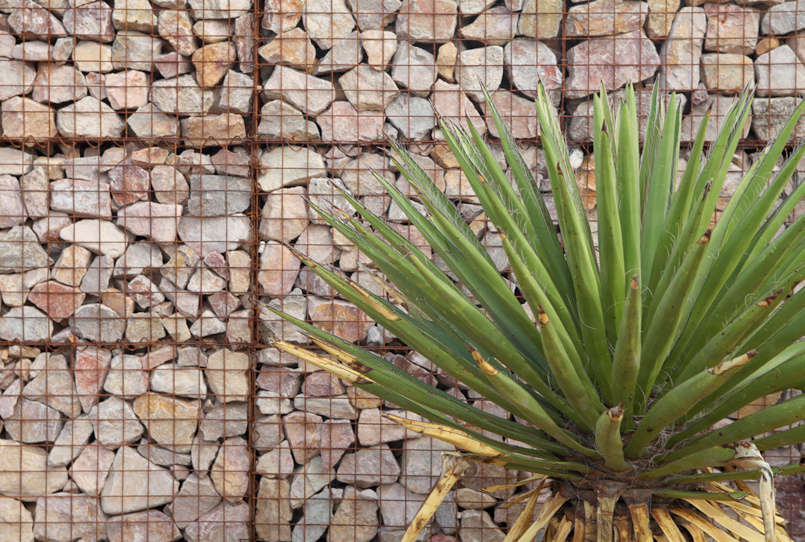From the banks of the Nile to your backyard, gabion walls are a boon to the landscape. Used for thousands of years by military and structural engineers, gabions provide an attractive, effective, and inexpensive retaining-wall system. Read on to find out how to use this ancient technology in your garden:

What are gabions?
Derived from an old Italian word, gabbione, meaning “big cage,” gabions are enclosures that can be filled with any sort of inorganic material: rock, brick, or concrete debris. The cages were originally wicker, but now are usually a welded mesh made of sturdy galvanized, coated, or stainless steel wire that won’t bend when filled with rocks. In landscaping, gabion walls can support an earth wall, stabilize the soil, prevent erosion, and more.


What is the history of gabion walls?
About 7,000 years ago, early gabion-type structures protected the banks of the Nile. In the medieval era, gabions were employed as military fortifications. Later they were used for structural purposes in architecture. Evidently, Leonardo da Vinci used gabion for the foundations of the San Marco Castle in Milan. In recent history, civil engineers have used gabions extensively to stabilize shorelines, riverbanks, highways, and slopes against erosion.

What are the benefits of gabion walls?
History has shown that gabions are a lasting solution to soil erosion. Other reasons to use them:
- Aesthetics: Gabions look natural and can tie a house to the landscape by using filler materials excavated from the site or the local terrain.
- Environmental friendliness: When onsite material is used as filler, transportation costs and associated fuel consumption are eliminated.
- Sustainability: Used as shade screens in hot climates, gabion walls provide passive cooling; they allow air to move through, providing ventilation.
- Permeability: Gabions are permeable and free-draining; they can’t be washed away by moving water.
- Easy installation and built-in strength: The stone fill settles to the contours of the ground beneath it and has such frictional strength that no foundation is required. In fact, the wall’s strength and effectiveness may increase with time, as silt and vegetation fill the voids and reinforce the structure. Another advantage over more rigid structures: Gabions can conform to ground movement.
- Long-lasting.


What material can you use to fill a gabion wall?
Rock is the most typical filler for its durability, longevity, and stability. Often the filler is chosen for its aesthetic attributes, or by what can be recycled from a site. Some considerations depend on a wall’s purpose. For a retaining wall, the rock must be dense enough to support the load. A hard rock such as basalt is typical.
N.B.: If you’re building a retaining wall, get a landscape architect or engineer to determine loads and stresses and other factors.

Any reason not to use gabion walls?
Gabion walls may come with one warning label: possible animal habitat. “Gabions can be nice hiding places for small critters,” says Ive Haugeland, principal at Shades of Green Landscape Architecture. “They’re good for wildlife habitat, but that needs to be OK with the people living there, too.”
Can I use gabions for more than just retaining walls?
Absolutely. Gabions can be reinvented for many garden uses: benches, outdoor fire surrounds, fence foundations, pond surrounds, planters, even pillars for water taps.

Note: Whenever gabion construction is used for fencing or screening, it needs the rigidity of a surrounding frame.
How much do gabions cost?
The price can vary widely, depending on:
Gabions: The cages are typically made of 3-inch mesh, which is sold in a range of sizes. According to Gabion Baskets, the industry standard is 3-foot increments. To estimate cost, figure on $35 per cubic yard (a 3-foot-square cage) for standard-gauge galvanized mesh. Gabion walls can be made in virtually any size (within structural limitations) for site-specific needs.
Filler: Here’s where you can exercise control over the price. Your filler could be expensive slate or free recycled concrete. For a large project, you often can find filler onsite.
Installation: Gabions are extremely affordable for a retaining wall or stone fencing, since little excavation or land preparation is needed. “It looks like the clients dropped hundreds and thousands of dollars,” says Kettelkamp, “but because they don’t require a foundation, it’s a very economical way to build a garden wall. The cost of labor is minimal compared to a traditional New England fieldstone wall.”

Gabion Wall Recap
Pros:
- A structurally sound way to prevent soil erosion and build a retaining wall
- Easy to install–no excavation or foundation required
- Affordable
- Attractive
- Environmentally friendly
- Long-lasting
Cons:
- Can provide a home for unwanted wildlife
- May be too bulky for small spaces
Love the look but don’t need a wall? See Rebecca Cole’s Gabion Furniture for a simple way to use it in your outdoor space.
Attracted to wire mesh? Consider Hog Wire Fencing. For more ideas, see all of our Hardscaping 101 Features.









Have a Question or Comment About This Post?
Join the conversation